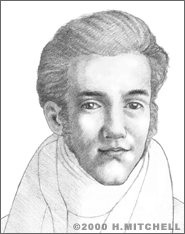Robert Fulton
Henry Ford did not invent the automobile; Samuel Morse did not invent the telegraph; nor did Robert Fulton invent the steamship. But like Morse and Ford after him, Fulton used his insight and energy to turn a challenge of engineering into a large-scale commercial success, thereby transforming the world.
Fulton was born in a farmhouse outside of Lancaster, Pennsylvania in 1765. At age 18, he left home for Philadelphia, hoping to make his fortune as an artist, specializing in miniature portraits. The Revolutionary War now over, Philadelphia was a hotbed of political, scientific, and commercial activity. After 1785, its figurehead was Benjamin Franklin, who had just returned from Europe. After painting Franklin's portrait, Fulton is said to have won his friendship and a letter of introduction to the artistic community of London, where he moved in 1786.
After exhibiting in the Royal Gallery in 1791, Fulton suddenly abandoned the fine arts for the "useful arts." His first efforts were in canal construction, but by 1793, he was designing steam-powered ships. After failing to impress the British Navy, which had designs of its own, Fulton moved on to France in 1797. There, he began working on submarines like David Bushnell's, for the French Navy to use against Britain's. In 1800, Fulton himself piloted his "Nautilus" for 17 minutes in 25 feet of water. But ultimately, the French Navy was not convinced to commit to the "plunging boat."
In 1804, Fulton returned to England, where he began to build submarines for the British Navy to use against the French. These included "torpedoes," floating mines that were launched, rather than propelling themselves. In a field test, Fulton blew a 300-ton ship in half.
In 1806, when he returned to the U.S. after 19 years, Fulton was considered a hero of the modern age. After he sunk a ship in a demonstration in New York Harbor, Congress forwarded him $5,000 for further experiments. On a loftier note, President Jefferson requested Fulton's help in building canals for the new territory of the Louisiana Purchase of 1803. Fulton declined; he had decided to solve the steamboat problem once and for all.
The steam-powered ship was first proposed in 1543 and was steadily attempted from 1707 on. One major problem was solved by a four-times more efficient steam engine, patented by James Watt in England in the year Fulton was born (1765). Another major problem was deciding on the optimal propulsion system. James Ramsey of Virginia had achieved some success with a jet engine that channeled the water through the length of the ship in 1788.
Fulton began a twofold effort to design a steamboat that would work. He contracted with Watt's firm in England for a special steam engine, with a number of improvements of his own. He also used models to develop the ideal shape for his ship. "Fulton's Folly" was flat-bottomed, wall-sided, and square-sterned, with paddle wheels midway along each side. Watt's engine was installed just forward of the wheels. The ship had fairly luxurious sleeping berths, a saloon, and a ladies' lounge. With later improvements, the total cost was about $20,000.
Fulton's efforts inspired, as he put it, "a number of sarcastic remarks." However, on August 17, 1807, the ship made its maiden voyage from New York to Albany (32 hours) and back (30 hours). Finally, Fulton could declare, "The power of propelling boats by steam is now fully proved." Not content with scientific success, Fulton put "The North River Steamboat of Clermont" into commercial service along the same route on September 4th. The cost was $7 one-way. The service ran without a hitch until mid-November when ice in the river became a problem.
Fulton obtained a patent for his steamboat (granted in just 42 days!) in 1809, with a second the next year for improvements thereof. More importantly, the state of New York granted him an exclusive right to steamboat transport on the Hudson River. Neither form of monopoly deterred Fulton's rivals from competing – which actually resulted in games of "chicken" and collisions in the river. Years later, Fulton vindicated his dubious patents, but the U.S. Court of Errors found the Hudson monopoly unconstitutional (1825).
Fulton's last major undertaking was the world's first steam-powered warship. The "Demologos" was 300 feet long, 200 feet wide, 120-horsepower, and double-hulled, with paddles between the inner and outer hulls, 44 guns on deck, and (slightly successful) underwater cannons. Although Fulton earned his last patents for this ship in 1813, the U.S. Navy let the project lie fallow after the War of 1812 ended in 1814.
In February of 1815, Fulton died from complications of a winter chest cold. In response, both houses of the U.S. Congress wore mourning clothes, and businesses in New York City closed for a day. Not everyone admired Robert Fulton, however. Many considered him, at best, a consummate opportunist. Yet Fulton the engineer was responsible for many innovative improvements, and Fulton the entrepreneur first made steamboat transportation a reality.


